2.
GHANA
Value of timber product exports increased despite lower export
volume
According to the report released by the Timber Industry
Development Division of Ghana, timber product exports
in December 2010 amounted to 30,200 cu.m worth Euro
10 million compared to 37,600 cu.m and Euro 9.8 million
in December 2009. Timber product exports thus fell 20%
in volume, but gained 2% in value.
The total value of timber products exported from January
to December 2010 was Euro 138 million compared to
Euro 128 million in 2009.
However, the export value of primary products including
poles and billets in 2010 was Euro 6.8 million compared to
Euro 12.6 million earned in 2009.
Exports of tertiary timber products were valued at Euro
10.2 million in 2010 increasing from Euro 8.1 million registered in 2009,
while exports of secondary timber products fetched Euro 121 million in 2010
compared to
Euro 107 million in 2009.
According to the report, exports to other African countries
were 191,000 cu.m in volume and Euro 53.5 million in
value in 2010. The ECOWAS countries including Nigeria,
Senegal, Niger, Gambia, Mali, Benin, Burkina Faso and
Togo accounted for Euro 49.1 million of the total exports
to African countries. Plywood and air-dried sawnwood
including ofram and ceiba continue to be in favour of
buyers in Nigeria and Niger.
Timber product exports to Europe in 2010 amounted to
85,000 cu.m worth Euro 40 million, with the main
destinations being Italy, France, Germany, the UK,
Belgium, Spain, Ireland and the Netherlands.
Emerging markets for Ghanaian timber products seem to
be in Asia and Far East including India, Malaysia, Taiwan
P.o.C, China, Singapore and Thailand. The value of timber
product exports to these countries was Euro 23.8 million
in 2010. India continues to be the major importer of
Ghanaian teak poles, billets and sawnwood.
The value of timber product exports to the Middle East
countries including Saudi Arabia, Lebanon, United Arab
Emirate and Israel together was Euro 10.5 million in 2010.
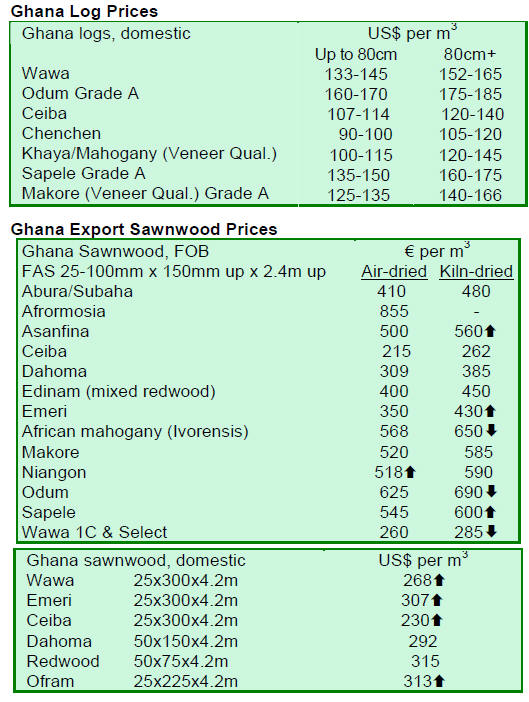
3.
MALAYSIA
Sarawak raises royalty on timber
In November 2008, the State Government of Sarawak
announced its intention to introduce a single flat royalty
rate for all logs at RM65 per cu.m to be effective from 1
January 2009. Following an appeal by the Sarawak Timber
Association, the Government agreed to a step-by-step
increase of the royalty rate: RM50 per cu.m in 2009,
RM55 per cu.m in 2010 and RM65 per cu.m in 2011 and
onwards.
However, due to the poor market situation in 2009 and
2010, the single flat royalty rate of RM50 per cu.m was
also applied in 2010. The royalty rate has been increased to RM65 per cu.m
for all logs effective from 1 January 2011.
More foreign workforce needed to meet export target
The value of timber and timber product exports from
January to November 2010 totalled RM18.8 billion, up
6.5% over the same period in 2009. Timber product
exports are projected to reach RM20.5 billion in 2010. In
2011, exports are forecast to further increase to RM21
billion - RM22 billion.
The National Timber Industry Policy (NATIP) sets an
export target of RM53 billion by 2020 for timber and
timber products. The target requires an annual export
growth of 6.4% with 60% of exports to be derived from
value-added products. The current share of value-added
products to timber product exports is 40%.
According to the Ministry of Plantation Industries and
Commodities, the Malaysian timber industry needs 50,000
more workers in order to meet the export target. In
addition, the furniture sector is experiencing a shortfall of
23,000 workers.
The current shortage of workers is attributed to several
restrictions imposed by the federal government to promote
the employment of local population as the global
economic slowdown continues. However, the Malaysian
timber industry is dependent on foreign labour. The
booming furniture sectors in Vietnam and China compete
with the Malaysian timber industry for foreign workforce.
According to a recent study conducted by the Malaysian
Timber Industry Board (MTIB), Forest Research Institute
of Malaysia (FRIM) and Malaysian Timber Council
(MTC), the production of value-added timber products
generated RM24 billion to the Malaysian economy in
2009.
Concern over increasing costs
The Sarawak Timber Association (STA) expressed
concern over the recent increases in fuel prices, freight
charges and cargo insurance costs. In addition, the STA
hopes that the federal government would be able to
provide more incentives for forest plantation projects as
well as for the use of lesser-known-species.
The industry is taking a break for the Chinese Lunar New
Year, with many of the workers returning to their
respective hometowns for the celebration.
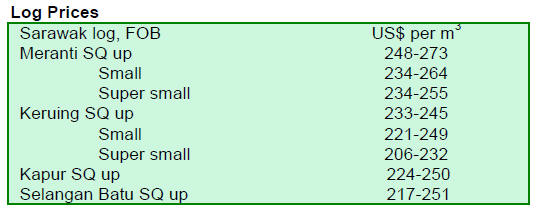
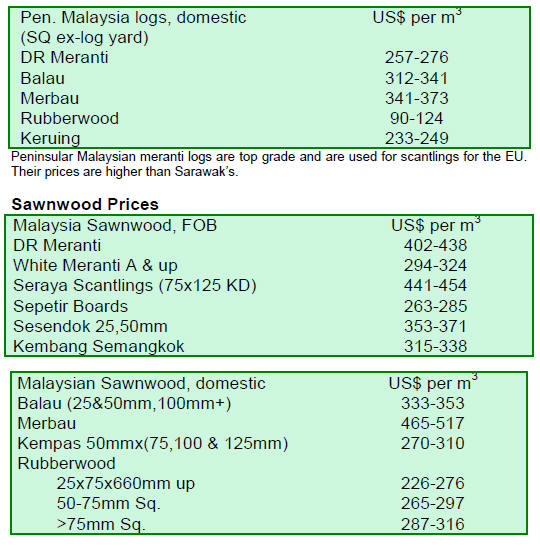
4.
INDONESIA
Germany is the largest market in Europe for
Indonesian rattan products
The largest furnishing exhibition in Germany, the imm
Cologne 2011, was held on 18 - 23 January 2011. The
Indonesian rattan industry made a comeback to the
exhibition after an absence of more than 25 years.
Altogether 12 Indonesian companies participated in the
exhibition.
At the exhibition, the Association of Furniture and
Handicraft Rattan of Indonesia (AMKRI) signed two
cooperation agreements: an exhibition cooperation
agreement with the Köln Messe and an agreement for
rattan design development programme with the German
Furniture Design and Marketing Development Institution.
Germany is the largest market in Europe for Indonesian
rattan products with Euro 18.5 billion of exports recorded
in 2008. In 2010, Indonesian rattan product exports to
Germany grew 2.7% following the economic growth of
2.5% recorded from January to October 2010 in Germany.
Concern over raw material supply
As it was reported earlier, the 2-year moratorium planned
to be implemented on 1 January 2011 in Indonesia has
been postponed. Companies with logging permits obtained
before 2010 are allowed to continue harvesting in primary
forests. The level of harvesting is expected to be finalised
during 2011.
However, the Indonesian Ministry of Forestry has
recently
ordered some timber companies to stop log harvests in
natural forests with immediate effect. The Ministry of
Forestry stresses the need to reorganise the management of
the pulp and paper industry in order to meet the new
conditions. Timber companies violating the order will
have their permits revoked.
Concerns have been expressed whether relying solely on
plantation forests for raw material supply is going to be
enough for the Indonesian timber industry to maintain and
develop its production. It is estimated that 50% to 60% of
raw material supply for the Indonesian timber industry
comes from natural forests.
The Indonesian timber industry is estimated to be worth
US$16 billion and employing annually around 240,000
workers. In 2010, the industry contributed US$4 billion to
state revenue, accounting for 6.1% of the total.
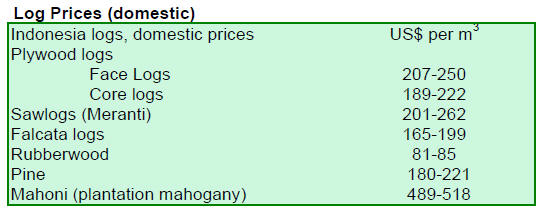
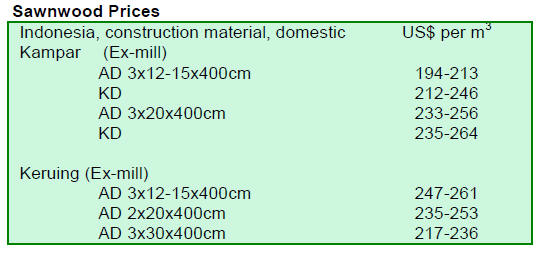
5.
MYANMAR
Mixed market outlook
The market situation for teak is reportedly good but the
Chinese Lunar New Year holidays have eased trading
towards the end of the month. With the arrival of fresh and
good quality logs, prices at Myanmar Timber Enterprise
(MTE) tender sales were favourable in January. Buying in
MTE tender sales was aggressive especially for the Indian
market.
The market situation for pyinkado has also improved.
However, buyers say that the export market for kanyingurjan
(Dipterocarpus spp) logs is still extremely slow.
Lower grade kanyin logs are processed for construction
timber in the domestic market.
Trade in eng (Dipterocarpus tuberculatus) for the Indian
market has been active but prices are lower than for
kanyin-gurjan (Dipterocarpus spp).
The Myanmar Kyat has appreciated against the US dollar
from about Kyat 1000/US$ to Kyat 850/US$ currently. As
a result, MTE tender prices in US dollars have attracted
local saw millers. In addition, with the strong Kyat,
processed products in the domestic market fetch higher
prices compared to export prices.
In general, log trade is similar to the previous year.
However, according to an analyst, grades and girths of
logs from natural forests have declined over the years.
Purchases of Myanmar teak by country in January
Purchases of Myanmar teak logs by country during
January 2011 were as follows: India (4 buyers, 257
Hoppus tons), Singapore (3 buyers, 214 Hoppus tons), and
Hong Kong (1 buyer, 63 Hoppus tons). In the domestic
markets there were four buyers, with timber sales totalling
80 Hoppus tons in volume.
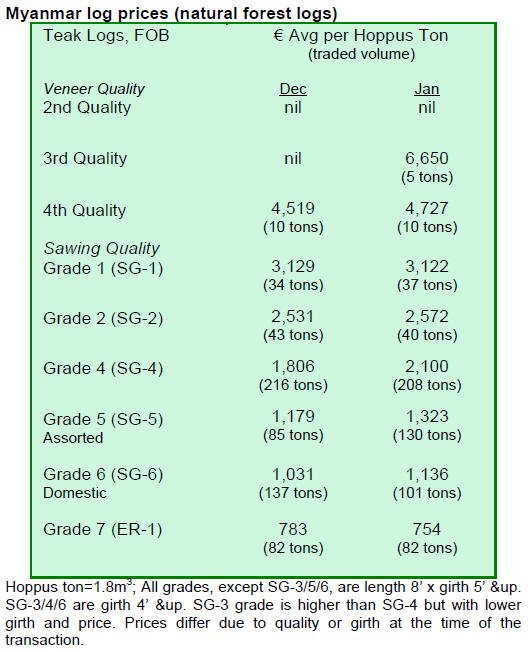
6. INDIA
Sharp jump in exports helps trim down
trade deficit
Exports from India grew 36.4% in December 2010 yearon-
year to US$22.5 billion, the highest level in 33 months.
Imports to India stood at US$25.1 billion in the same
month, resulting in the narrowing of trade deficit to
US$2.6 billion.
Increasing demand for industrial wood
India¡¯s consumption of paper and paper products of 5 kg
per person per year is among the lowest in the world. For
comparison, levels of consumption per capita of paper and
paper products in the USA, UK and China are 300 kg, 200
kg and 45 kg respectively.
However, improved education and continuing economic
growth are expected to contribute to a rapid increase in
consumption of paper products in India. Companies are
intensifying agro-forestry activities to meet increasing
demand for pulp-wood.
In social forestry, there are efforts to plant more
fruit
bearing trees as well as neem, eucalyptus, casuarina,
poplar and rubber wood. In the district of Gujarat in
western India, rubberwood plantations are being promoted
on an experimental basis, helping in the greening of the
country and providing employment to local communities.
According to an analyst, wastelands can contribute to
alleviating the shortage of raw materials if the government
allows for the growing of industrial woods and bamboos in
these areas.
Red sandalwood seized
The smuggling of red sandalwood (Pterocarpus santalinus)
out of India appears to be continuing. However, Indian
Customs have been successful in seizing illegal shipments.
Red sandalwood is mainly shipped to China, Taiwan and
Japan for the manufacture of medicine and musical
instruments. Extracts of red sandalwood are also used as
effective coolants in nuclear reactors and this has created a
new market in China. The total seizure of red sandalwood
in 2010 amounted to 230 metric tonnes worth Rs.210
million.
Active auction sales in government depots
Timber auction sales in Central and Western Indian
Government depots continue to be active with steady
demand and prices. Sales have amounted to over 10,000
cu.m of hardwood logs.
Long length quality teak logs fetched Rs.2100-2200
per
cu.m, medium sawing quality teak logs were at Rs.1700-
1800 per cu.m, long length medium girth at Rs.1500-1600
per cu.m, and lower grades were priced at Rs.900-1000
per cu.m.
Hardwoods like adina, laurel and kinowood (Pterocarpus
marsupium) fetched Rs.800 for select qualities and Rs.400
for lower grades. Demand is good for these species, but
supplies are inadequate.
Timber market outlook
Timber and wood products are in good demand in the
Indian market and prices are firming. The shortfall of
supply of non-teak hardwoods is met through imports of
Malaysian hardwood logs.
Teak trade is active and prices trend upwards due to
continuing demand from Europe, the USA and Middle
East. Higher log prices are pushing sawnwood prices up.
Demand for plywood is also steady. Local production
costs are rising but imports of plywood and other panel
products from China make it difficult for Indian producers
to pass these costs to the consumers.
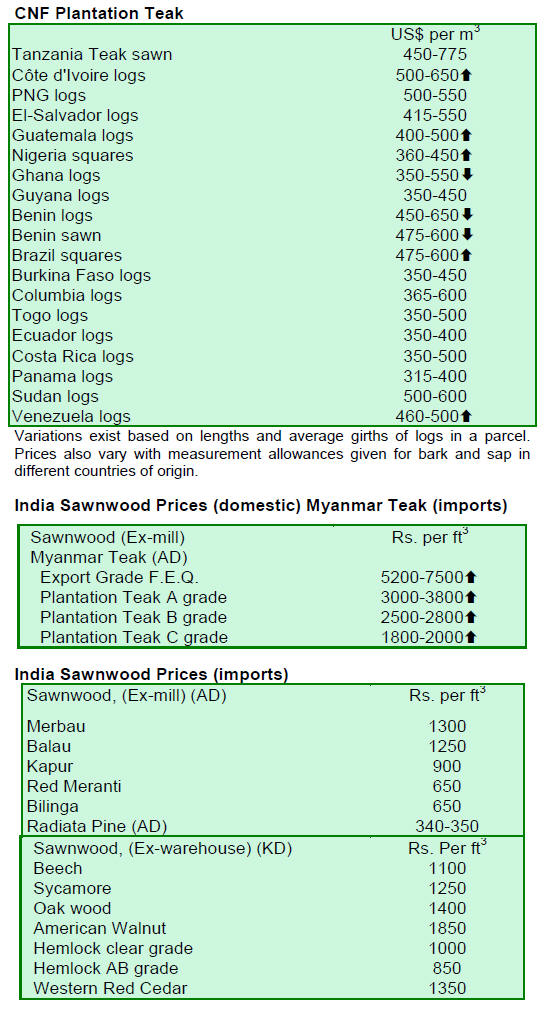
7. BRAZIL
Timber product prices on an upward trend
The average price of timber products in Brazil in BRL
increased by 2.1% from the previous fortnight. Prices in
US dollars also gained 0.59% due to the slight
appreciation of the Brazilian currency against the US
dollar.
Mixed performance of wood product exports in
last
two months of 2010
In November 2010, the value of timber product exports
(excluding pulp and paper) increased 7.6% to US$204
million from US$189 million in November 2009. Exports
of timber products continued to improve in December
showing 2.5% increase compared to December 2009, from
US$219 million to US$224 million.
In November, exports of tropical sawnwood rose in
terms
of both volume and value, from 48,400 cu.m worth
US$25.7 million recorded in November previous year to
53,200 cu.m worth US$28 million. However, exports
declined in December from 49,100 cu.m worth US$25.5
million recorded in December previous year to 42,300
cu.m worth US$23.1 million.
Exports of tropical plywood plunged 28%
year-on-year in
November, from 9,900 cu.m to 7,100 cu.m, but increased
11% year-on-year in December, from 8,100 cu.m to 9,000
cu.m. In value terms, a 28.6% decline was recorded yearon-
year in November, from US$5.6 million to US$4.0
million, followed by a rebound of 16.3% in December,
from US$4.9 million to US$5.7 million.
Pine sawnwood exports surged 35% year-on-year in
November, from 40,900 cu.m to 55,300 cu.m, but slid
17.1% year-on-year in December, from 65,900 cu.m to
54,600 cu.m. In value terms, a 62% jump was recorded
year-on-year in November, from US$7.8 million to
US$12.6 million, followed by a 3.8% decline in December,
from US$13 million to US$12.5 million.
Pine plywood exports increased 0.8% year-on-year in
November, from 85,000 cu.m to 85,700 cu.m and
advanced further in December by 13% year-on-year, from
83,300 cu.m to 94,400 cu.m. In value terms, a 15%
increase was recorded year-on-year in November, from
US$26.4 million to US$30.3 million, and a further surge
of 23% in December, from US$27.1 million to US$33.4
million.
In contrast, the value of wooden furniture exports
slipped
0.2% in November and 3.4% in December year-on-year to
US$46.6 million and US$51.4 million respectively.
Authorities monitor inflationary trends in
economy
According to the Brazilian Institute of Geography and
Statistics (IBGE), the Consumer Price Index (IPCA) rose
0.83% in November and 0.63% in December year-on-year.
The accumulated IPCA for the year 2010 was 5.91%, 1.6
percentile points above the 2009 rate (4.31%)
In November 2010, the average exchange rate for BRL
to
the US dollar was BRL1.71/US$ compared to BRL
1.73/US$ during the same month of 2009. In December
2010, the average exchange rate stood at BRL 1.69/US$,
compared to BRL 1.75/US$ in December 2009. This
shows that BRL has further strengthened against the US
dollar over the period.
The Copom (Economic Policy Committee) has kept the
prime interest rate (Selic) at 10.75% since July 2010.
Brazilian Forest Service aims at expanding
national forests (FLONAS)
It was reported earlier that the area available for forest
concessions in the Brazilian Amazon exceeded 1 million
hectares. Recently the Brazilian Forest Service (SFB)
announced its intention to increase forest concession areas
for logging companies and forest areas for community
management. Furthermore, SFB will speed up the forest
concession approval process.
According to SFB, there are 50 million hectares of
forests
which can potentially be turned into national managed
forests (FLONAS). At least 35 million hectares of national
managed forests would be required in order to meet
current timber demand.
In addition, part of the future timber supply will
come
from community forest management projects aimed at
offering sustainable economic alternatives to illegal
logging. SFB believes that community forest management
projects are among those likely to receive international
funds in the coming years.
New export strategy for furniture manufacturers
in 2011
According to the Chamber of Furniture Industry
Development of FIESC (Federation of Industries of the
state of Santa Catarina), the furniture manufacturers of
Santa Catarina will focus on selling more furniture in the
domestic market. The strategy change is due to the
weakening of US dollar against the Brazilian Real. Santa
Catarina is the major state in Brazil exporting furniture.
In 2009, furniture sales in the domestic market
grew 5.2%
compared to 2008. In October 2010, the accumulated
furniture sales were up by 20% over the same period in
2009.
The value of furniture exports from Santa Catarina
was
US$260 million in 2009, accounting for 31% of the total
Brazilian furniture exports. In the period from January to
November 2010, furniture exports totalled US$248 million
in value. The main export destinations were the US,
France, the UK, the Netherlands, Spain and Germany.
Brazil stands out in furniture production
According to the Italian Research Institute (CSIL), Brazil
is the world¡¯s 13th largest furniture supplier and its
industry is growing. The institute predicts that the
Brazilian furniture industry will grow by 3% ¨C 4% in 2011
and 2012.
According to CSIL, besides the economic growth in
Brazil,
the expansion of the furniture industry is due to several
other factors, such as the significant expansion in civil
construction, growing middle class, and the country¡¯s
competitive position in the international market. In the
next two years, furniture consumption will be much
greater in emerging economies than in developed
economies.
A large share of furniture production and sales is
concentrated in the Southern and Southeast regions of
Brazil. The furniture cluster consists of about 15,000
micro and small-sized companies. The annual panel
production capacity is expected to grow from 6 million
cu.m to 10.3 million cu.m by 2012.
Brazilian furniture sales hit a record high in
2008. In 2009,
sales went down due to the global economic crisis and stiff
competition from Asian products. However, according to
CSIL, furniture consumption increased in the Southern
and Southeast regions of Brazil in 2010.
IBAMA introduces new timber export control
The Document of Forest Origin (DOF) used since 2006 to
control the trade in forest products in the Brazilian
domestic market has been adapted to be used for the
export markets. The new module called ¡°DOF Export¡±
commenced operation on 10 January 2011 with the aim of
improving transparency of the public administration and
reducing bureaucracy.
DOF Export will be integrated to the state forest
control
system. Under the previous system, an entrepreneur had to
register a timber courtyard in every export warehouse.
With the new system, these warehouses are already preregistered
and thus duplication is avoided.
DOF can be also used as a REDD (Reducing Emissions
from Deforestation and Degradation) tool to evaluate the
legality of wood products originating from Brazil. The
new system includes also a government database
consisting information about foreign buyer companies.
With these features, a foreign buyer is guaranteed of the
legality of wood products, thereby improving and
enhancing the competitiveness of Brazilian forest products
in the international markets.
IBAMA has received delegations from several
tropical
forest countries, such as Indonesia, Ghana and Bolivia,
which have shown their interest in adopting the Brazilian
technology to control the forest products flow.
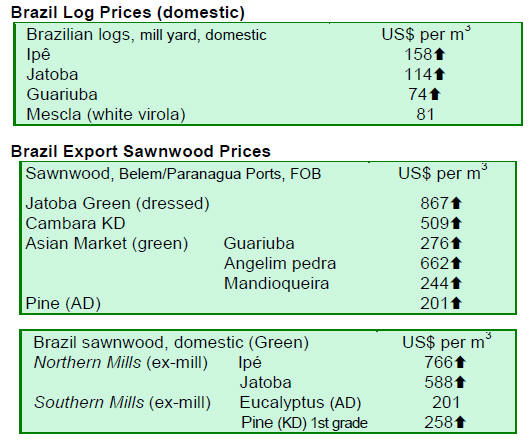
8.
PERU
Appeal for Congress to pass Forestry and Wildlife Law
The Peruvian Exporters¡¯ Association (Adex), the National
Society of Industries (SIN) and the National Forest
Chamber have appealed to the Congress to pass the
Forestry and Wildlife law in March. According to these
bodies, an adequate legal framework would help the sector
to boost exports and create jobs.
Call for integrated policies for the forestry sector
The export performance of wood and timber products in
2011 is expected to be lower than in 2010 if the next
government does not commit to support the sector, said
Eric Fischer, Chairman of the Wood Committee, Peru
Exporters Association.
According to Fischer, the regional governments are
lacking in resources and integrated State policies to
support and promote the forestry sector in Peru.
Significant losses from deforestation
An impact analysis of deforestation in Pichis-Palcaz¨² of
the Pasco region shows a loss of some US$750 - US$811
million in revenue in the next 30 years period due to
deforestation.
The analysis considered the losses in opportunities and
revenues from sustainable forest management, involving a
total area of 1,4 million hectares. According to estimates,
some 269,000 hectares were deforested in 2007, with 57%
of the deforested area turned into pastureland and the
remaining 43% into shifting cultivation.
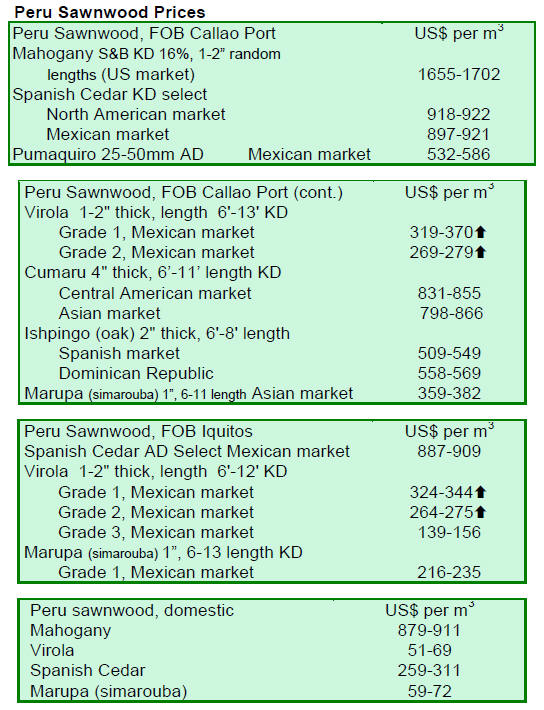
9.
BOLIVIA
Forest product exports surged in 2010
Forest product exports from Bolivia totalled US$237
million in 2010, up 33% from US$178.8 million in 2009.
Furniture, doors, panels, decking (as well as peeled
chestnut and canned palm hearts) accounted for 82%
(US$195.4 million) of the total forest product exports,
while the remaining 18% (US$42.4 million) consisted of
primary processed wood products, such as sawnwood and
poles.
The US remains the major market for Bolivian forest
products taking some US$55.5 million, which accounted
for 23.4% of the total forest product exports from Bolivia.
Other major export destinations were the UK (US$36.6
million), Venezuela (US$15.3 million), the Netherlands
(US$14.5 million), and China (US$13.5 million).
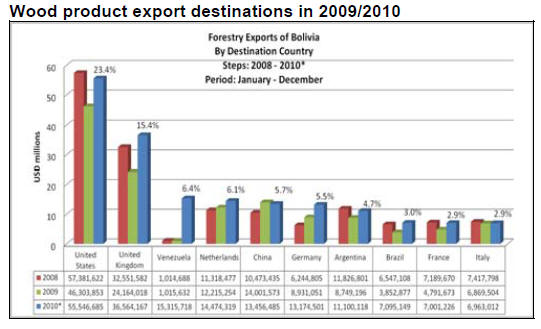
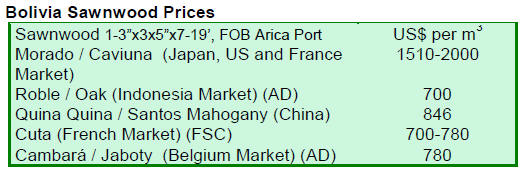
Related News: